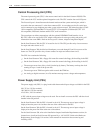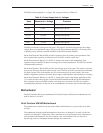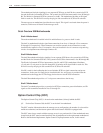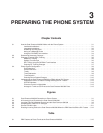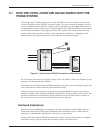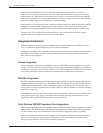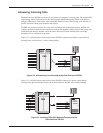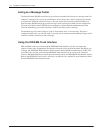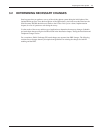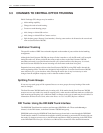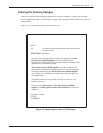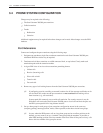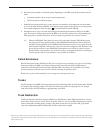
3-2
Installation and Maintenance
Volume
Octel Overture 200/300 Serenade 3.0
PB60014–01
An
Octel Overture 200/300 port is in use during the entire time it takes to answer a call, dial the
extension the caller entered, and connect the caller to the requested extension. The port is then free to
handle another call. When the called extension is busy or does not answer
, the Octel Overture 200/300
port remains occupied while calling another extension or taking a message. An
Octel Overture 200/300
port is in use when employees are listening to or sending messages.
Port extensions answering with the same company greeting and answering mode are placed in a hunting
arrangement within the PBX. The hunt group may be circular or linear (terminal) according to the
requirements of each particular PBX. This assures that callers are answered by the first available port.
The mode (AX, CX, or MX) of the port determines how calls are answered by the Octel Overture
200/300. Refer to the
Configuration
volume, Slots T
able chapter
.
Integrated Installations
Different
methods are used to integrate a telephone system with the Octel Overture 200/300. In some
cases, a combination of these methods may be used for full integration.
Integration is the ability of the telephone system to provide the Octel Overture 200/300 with information
that identifies the extension number a call was intended for and, in some cases, the extension number
from where the call originated.
In-band Integration
In-band
integration is the ability of a telephone system to send DTMF tones that identify the extension
number for a forwarded call to the port extension answering the call. In-band signalling may include the
condition (busy
, ring-no-answer
, or direct) for the call. In certain installations, DTMF tones may be used
to turn ON or OFF message waiting indicators to indicate when a mailbox has new messages.
RS-232C Integrations
RS-232C
integrations include the Bell Operating Company’
s (BOC) Simplified Message Desk Interface
(SMDI) and those that are similar to it. The SMDI or RS-232C interface provides the directory number
,
or PBX extension number of the called extension from which an incoming call was forwarded, to the
message desk. If the call originated in the same PE or PBX, the directory number or extension number is
sent to the message desk.
The condition or reason the call was forwarded to the message desk, as well as the port or member of the
hunt group the call is being sent to, is included in the call record. Message waiting indication may be
turned ON or OFF over RS-232C connections for most installations.
Octel Overture 200/300 Proprietary Card Integrations
Octel
has developed proprietary line cards that function similarly to digital display telephones for several
dif
ferent PBXs. The Octel Overture 200/300 reads the proprietary line cards to determine the extension
and the condition for the call, and then answers the call with the appropriate greeting or response.
Once the extension and condition for the forwarded call is known, an analog
port answers the call and
provides all remaining messaging functions. The proprietary line cards are used to turn ON or OFF
message waiting indicators in most of the proprietary integrations.



